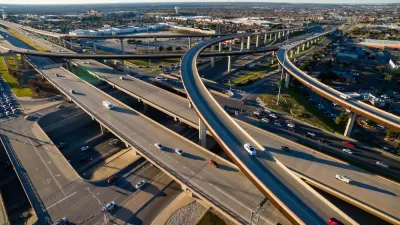Despite evidence that widening roadways is only a temporary solution to congestion, a decades-long inertia leads states to continue pushing expansion projects against local opposition.

By now, the phenomenon of induced demand forms a common refrain among transportation planners: "adding lanes won’t cure snarled traffic; the additional car space inevitably invites more trips, until gridlock is as bad as ever." But, as David Zipper writes, despite repeated evidence that widening roads only leads to more traffic, agencies like the Texas Department of Transportation continue to plow ahead with expansion plans. In Austin, TxDOT has plans to widen Interstate 35, already a behemoth at twelve lanes.
The "iron law of congestion," as induced demand is otherwise known, "applies not only to U.S. cities, which have grown more traffic-jammed despite billions of dollars in fresh pavement, but also to those around the world." Zipper wonders, then, why it has been such an uphill battle for "for officials to recognize the futility of urban roadway expansion." Zipper posits that highway planners "are operating within a political and financial system that rewards new construction, despite its consistent failures to reduce congestion," leading agencies to "continue repeating the same predictable, costly mistakes."
Urban street widening began in earnest in the 1920s, as automobiles became more available and traffic began to choke American city streets. Yet as far back as 1927, "an engineer named Arthur S. Tuttle warned that the new urban roads 'would be filled immediately by traffic which is now repressed because of congestion.' His prediction held true." The next step for planners was creating expressways aimed at speeding up traffic and avoiding the delay caused by stoplights. This didn't solve the congestion problem either. In addition to the destruction wreaked on Black neighborhoods, expressways "were a failure even by their own standards."
One problem, according to Beth Osborne of Transportation for America, is that "[t]he federal government doesn’t penalize states for getting their congestion mitigation estimates wrong." Meanwhile, "[s]tate DOTs are expanding interstates even in places such as Akron that have seen population declines, in the process fostering spread-out development patterns that require more driving." State DOTs also have an interest in increasing miles traveled, as the gas tax paid by drivers directly funds their departments.
"There are signs that this approach is starting to change — at least in some places," but "turning down a new highway lane remains politically challenging," as the concept of induced demand continues to raise eyebrows among those who haven't studied the evidence and "politically potent contractors, unions and automakers have an incentive to keep the public confused."
To move the needle, "federal officials could provide a nudge — or a shove — to encourage local and state transportation planners to acknowledge induced demand’s reality." In March of this year, the "FHWA halted TxDOT’s I-45 expansion in Houston, a move celebrated by environmental advocates and local officials" that signals a potential shift in federal policy that could encourage state DOTs to rethink widening projects in favor of more effective, sustainable solutions to traffic problems.
FULL STORY: The Unstoppable Appeal of Highway Expansion

Study: Maui’s Plan to Convert Vacation Rentals to Long-Term Housing Could Cause Nearly $1 Billion Economic Loss
The plan would reduce visitor accommodation by 25,% resulting in 1,900 jobs lost.

North Texas Transit Leaders Tout Benefits of TOD for Growing Region
At a summit focused on transit-oriented development, policymakers discussed how North Texas’ expanded light rail system can serve as a tool for economic growth.

Why Should We Subsidize Public Transportation?
Many public transit agencies face financial stress due to rising costs, declining fare revenue, and declining subsidies. Transit advocates must provide a strong business case for increasing public transit funding.

How Community Science Connects People, Parks, and Biodiversity
Community science engages people of all backgrounds in documenting local biodiversity, strengthening connections to nature, and contributing to global efforts like the City Nature Challenge to build a more inclusive and resilient future.

Alabama: Trump Terminates Settlements for Black Communities Harmed By Raw Sewage
Trump deemed the landmark civil rights agreement “illegal DEI and environmental justice policy.”

Dear Tesla Driver: “It’s not You, It’s Him.”
Amidst a booming bumper sticker industry, one writer offers solace to those asking, “Does this car make me look fascist?”
Urban Design for Planners 1: Software Tools
This six-course series explores essential urban design concepts using open source software and equips planners with the tools they need to participate fully in the urban design process.
Planning for Universal Design
Learn the tools for implementing Universal Design in planning regulations.
City of Santa Clarita
Ascent Environmental
Institute for Housing and Urban Development Studies (IHS)
City of Grandview
Harvard GSD Executive Education
Toledo-Lucas County Plan Commissions
Salt Lake City
NYU Wagner Graduate School of Public Service





























